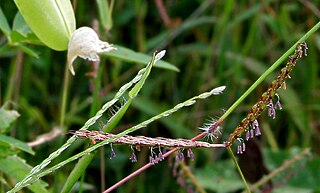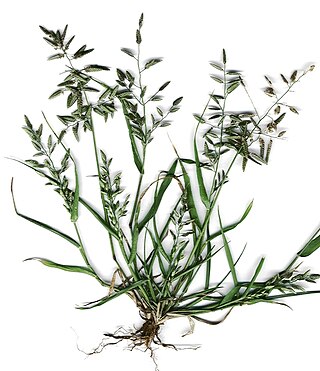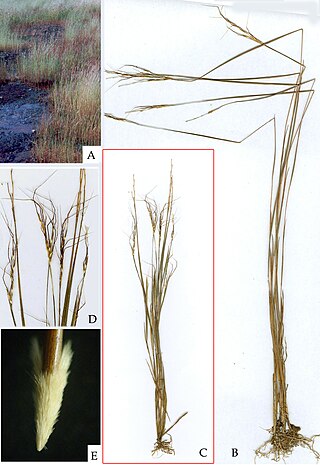
The Bambuseae are the most diverse tribe of bamboos in the grass family (Poaceae). They consist of woody species from tropical regions, including some giant bamboos. Their sister group are the small herbaceous bamboos from the tropics in tribe Olyreae, while the temperate woody bamboos (Arundinarieae) are more distantly related. The Bambuseae fall into two clades, corresponding to species from the Neotropics and from the Paleotropics.

Panicoideae is the second-largest subfamily of the grasses with over 3,500 species, mainly distributed in warm temperate and tropical regions. It comprises some important agricultural crops, including sugarcane, maize, sorghum, and switchgrass.

The Bambusinae are a subtribe of bamboo. It comprises 17 genera.

Andropogon is a widespread genus of plants in the grass family, native to much of Asia, Africa, and the Americas, as well as Southern Europe and various oceanic islands.

Ischaemum is a genus in the tribe Andropogoneae, belonging to the grass family, widespread in tropical and semitropical regions in many countries. Many species are known commonly as murainagrass.

Eragrostideae is a tribe of grasses in subfamily Chloridoideae. It contains roughly 500 species, which all use the C4 photosynthetic pathway.

The Stipeae are a tribe of grasses within the subfamily Pooidae, with up to 600 described species.

Oryzoideae (syn. Ehrhartoideae) is a subfamily of the true grass family Poaceae. It has around 120 species in 19 genera, notably including the major cereal crop rice. Within the grasses, this subfamily is one of three belonging to the species-rich BOP clade, which all use C3 photosynthesis; it is the basal lineage of the clade.

Anomochlooideae is a subfamily of the true grass family Poaceae. It is sister to all the other grasses. It includes perennial herbs that grow on the shaded floor of forests in the Neotropics. There are two genera, Anomochloa and Streptochaeta, each in its own tribe.

Paniceae is a large tribe of the subfamily Panicoideae in the grasses (Poaceae), the only in the monotypic supertribe Panicodae. It includes roughly 1,500 species in 84 genera, primarily found in tropical and subtropical regions of the world. Paniceae includes species using either of the C4 and C3 photosynthetic pathways, as well as presumably intermediate species. Most of the millets are members of tribe Paniceae.

Micrairoideae is a subfamily of the grass family Poaceae, distributed in tropical and subtropical regions. Within the PACMAD clade, it is sister to subfamily Arundinoideae.

Arundinelleae is a tribe of grasses with roughly 90 species in three genera, mainly distributed in tropical and subtropical areas. The tribe's sister group are the Andropogoneae, with which they are classified in supertribe Andropogonodae. All species in this tribe use C4 carbon fixation.

Paspaleae is a tribe of the Panicoideae subfamily in the grasses (Poaceae), native mainly to the tropical and subtropical Americas but with a number of species introduced to other regions. It includes roughly 680 species in 39 genera. Species in this tribe use either of the C3 or C4 photosynthetic pathways.

Tristachyideae is a tribe of the Panicoideae subfamily in the grasses (Poaceae), native to tropical and subtropical regions of Africa, Asia, and South America. There are around 70 species in eight genera. The tribe belongs to a basal lineage within the subfamily, and its genera were previously placed in tribes Arundinelleae or Paniceae, subfamily Arundinoideae, or the now-obsolete subfamily Centothecoideae. Species in this tribe use the C4 photosynthetic pathway.

Chasmanthieae is a small tribe of grasses in the subfamily Panicoideae. It belongs to a basal lineage within the subfamily and has only seven species in two genera, Bromuniola with one species in Africa and Chasmanthium from North America. They all use the C3 photosynthetic pathway.

Ischaemum rugosum, also known as saramollagrass, is a flowering plant belonging to the grass family Poaceae in the genus Ischaemum, and is native to tropical and temperate regions of Asia, growing in marshes and other wet habitats. It is a vigorous annual, and is an invasive species in South America and Madagascar. It reaches heights of up to 1 m and is primarily recognized by the ridged surface of its sessile spikelet’s lower glume. Despite its historic importance as fodder in Asia, the grass has become a major weed in mid-latitude rice paddies throughout Asia and South America.

Rottboellia cochinchinensis is a species of grass known by the common names Itchgrass,Raoul grass, corngrass, Kokoma grass, Guinea-fowl grass, jointed grass, Shamwa grass and Kelly grass. It is a tall, tufted annual grass whose stems (culms) grow up to 3 metres in height with leaf-blades of up to 45 centimetres in length. The species flowers at the apex of culms in the form of spike-like racemes composed of paired spikelets. The common name Itchgrass comes from the bristly (hispid) leaf-sheath which can be irritating to the skin.
Claviceps pusilla, also known as bluestem ergot, is a parasitic fungus primarily of the grass tribe Angropogoneae, particularly those in the tribe referred to as "bluestem". C. pusilla occasionally manifests characteristic triangular conidia which appear to be unique among Claviceps species.

Nanooravia is a monotypic genus of flowering plants belonging to the family Poaceae. The only species is Nanooravia santapaui, an annual grass, and its native range is Southern India.


















